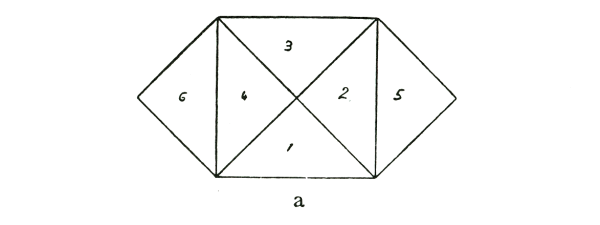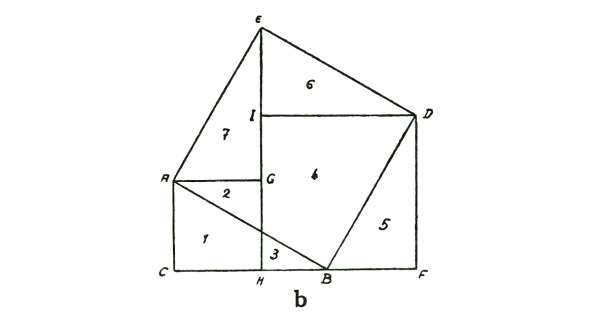|
APPENDIX TO
LECTURE 5
I. Proof
for the Theorem of Pythagoras.
(As it
has been impossible to reproduce the diagrams in colour, the forms
which Dr. Steiner referred to by their colours have been indicated by
letters or numbers.) It is quite easy to do this proof if the
triangle is isosceles. If you have here a right-angled isosceles
triangle (see diagram a.), then this is one side, this is the other
and this the hypotenuse. This square (1, 2, 3, 4) is the square on
the hypotenuse. The squares (2, 5) and (4, 6) are the squares on the
other two sides.
Now if I
plant potatoes evenly in these two fields (2, 5) and (4, 6), I shall
get just as many as if I plant potatoes in

this field
(1, 2, 3, 4). (1, 2, 3, 4) is the square on the hypotenuse, and the
two fields (2, 5) and (4, 6) are the squares on the other two
sides.
You can
make the proof quite obvious by saying: the parts (2) and (4) of the
two smaller squares fall into this space here (1, 2, 3, 4, the square
on the hypotenuse); they are already within it. The part (5) exactly
fits in to the space (3), and if you cut out the whole thing you can
take the triangle (6) and apply it to (1), and you will see at once
that it is the same. So that the proof is quite clear if you have a
so-called right-angled isosceles triangle.
If
however you have a triangle that is not isosceles, but has unequal
sides (see diagram b.), you can do it as follows:

draw the
triangle again ABC; then draw the square on the hypotenuse ABDE.
Proceed as follows: draw the triangle ABC again over here, DBF. Then
this triangle ABC or DBF (which is the same), can be put up there,
AGE. Since you now have this triangle repeated over there, you can
draw the square over one of the other sides, CAGH.
As you
see, I can now also draw this triangle DEI congruent to BCA. Then the
square DIHF is the square on the other side. Here I have both the
square on the one side and the square on the other side. In the one
case I use the side AG and in the other case the side DI. The two
triangles AEG and DEI are congruent. Where is then the square on the
hypotenuse? It is the square ABDE. Now I have to show from the figure
itself that (1, 2) and (3, 4, 5) together make up (2, 4, 6, 7). Now I
first take the square (1, 2); this has the triangle (2) in common
with the square on the hypotenuse ABDE and section (4) of the square
on the other side HIDF is also contained in ABDE. Thus I get this
figure (2, 4) which you see drawn here and which is actually a piece
of the square ABDE. This only leaves parts (1, 3 and 5) of the
squares AGHC and DIHF to be fitted into the square on the hypotenuse
ABDE. Now you can take part (5) and lay it over part (6), but you
will still have this corner (1, 3) left over. If you cut this out you
will discover that these two areas (1, 3) fit into this area (7). Of
course it can be drawn more clearly but I think you will understand
the process.
|